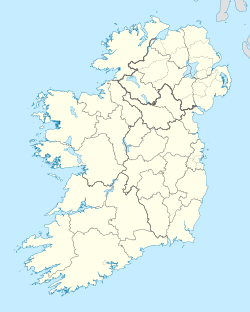Hill of Uisneach
 Information sign | |
| Alternative name | Ushnagh (anglicisation) |
|---|---|
| Location | County Westmeath, Ireland |
| Coordinates | 53°29′24″N 7°33′43″W / 53.490°N 7.562°W |
| Type | Ancient ceremonial site |
| Height | 182 metres (597 ft) |
| History | |
| Periods | Iron Age–Middle Ages |
| Cultures | Gaelic |
| Site notes | |
| Public access | Yes |
| Official name | Ushnagh Hill, Catstone |
| Reference no. | 155 |
The Hill of Uisneach or Ushnagh (Uisneach or Cnoc Uisnigh)[1] is an ancient ceremonial site in the barony of Rathconrath in County Westmeath, Ireland (National Monument Number 155).[2] While it is not the exact geographical centre of Ireland, in Irish mythology it is often considered to be the symbolic center of the land,[3] and is associated with the fire festival of Bealtaine. The hill is 182 metres (597 ft) tall[4] and lies on the north side of the R390 road, 8 km east of the village of Ballymore and beside the village of Loughanavally. The Hill of Uisneach occupies parts of four adjacent townlands: Ushnagh Hill, Mweelra, Rathnew, and Kellybrook.[4]
The site consists of a set of monuments and earthworks spread over two square kilometres. Around and upon the hill are the remains of circular enclosures, barrows, cairns, a holy well and two ancient roads. On the southwest side of the hill is a large, oddly-shaped limestone rock inside a circular enclosure. It is almost 6 metres (20 ft) tall and thought to weigh over 30 tons. In Irish it is called the Ail na Míreann ("stone of the divisions"), as it is said to have been where the borders of the provinces met. It is nicknamed the Cat Stone, allegedly because it resembles the shape of a sitting cat. The biggest enclosure was excavated in the 1920s by R.A.S. Macalister and R. Praeger and showed evidence of occupation from pre-history up to the early Middle Ages.

Based on co-ordinates alone, some believe that it may be the site named as Raiba or Riba by Claudius Ptolemaeus (Ptolemy), the Egyptian-Greek astronomer and cartographer, writing in his Geographia around the year 140 AD.[citation needed]
The actual geographical centre of Ireland is near the western shore of Lough Ree, further to the west.[5]
In Irish mythology
While Irish mythology and cosmology have foundational differences from classical mythology, the ceremonial centre of the land could be compared to a type of Axis Mundi, and the Ail na Míreann or "stone of divisions" a type of omphalos, or mystical navel, of Ireland and to have marked the meeting point of the borders of Leinster, Munster, Connacht, Ulster and Meath. Tradition tells that Bealtaine fires were lit and Druidical ceremonies held on the hill. In the Lebor Gabála Érenn (Book of the Takings of Ireland), the Nemedian Druid Mide lit the first Bealtaine fire there. This fire could allegedly be seen from the Hill of Tara and, when those at Tara saw it, they lit their fire.
There is reference to the name in the story of "Deirdre of the Sorrows", one of the best known stories of pre-Christian Ireland. Deirdre was born with a prediction that her beauty would be so great that Kings would wage wars to fight for her. Conchobar mac Nessa, King of Ulster, kept her hidden away from birth for himself in the future. When older she falls in love with Naoise, a handsome young warrior, hunter and singer at Conchobar's court. They escape to Scotland accompanied by his fiercely loyal brothers Ardan and Ainnle, the sons of Uisneach.
According to a popular passage from the same record, Ériu, a tutelary goddess sometimes seen as the personification of Ireland, meets the invading Milesians at Uisneach where, after some conversation and drama, the Milesian poet Amergin promises to give the country her name. Geoffrey of Monmouth's Historia Regum Britanniae ("History of the Kings of Britain") claims a common belief that the stones of Stonehenge were brought to Britain from Uisneach.
See also
References
- ^ Irish Placenames Database Retrieved 5 August 2010.
- ^ National Monuments in State care Archived 20 February 2010 at the Wayback Machine, National Monuments Service, archaeology.ie. Retrieved 5 August 2010.
- ^ Alwyn and Brinley Rees. Celtic Heritage. Thames and Hudson: New York, 1961. ISBN 0500270392. pp. 159-161.
- ^ a b Ordnance Survey map. Select Wind Report option for contour map. Select Historic 6" option for townland boundaries. Retrieved 5 August 2010.
- ^ Frequently Asked Questions Archived 28 February 2012 at the Wayback Machine Ordnance Survey Ireland. Retrieved: 25 June 2011.
Further reading
- Jestice, Phyllis G. (2000). Encyclopedia of Irish Spirituality. Santa Barbara, California: ABC-CLIO, Inc. ISBN 1-57607-146-4.
- MacKillop, James (1998). Dictionary of Celtic Mythology. New York City: Oxford University Press. ISBN 0-19-869157-2.


